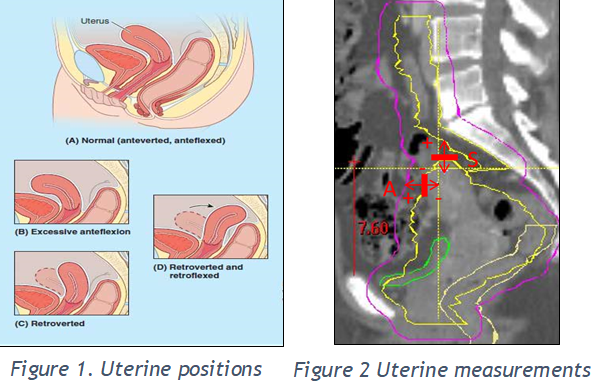Exploring uterus motion with full and empty bladder in preparation for adaptive cervix radiotherapy
PO-1848
Abstract
Exploring uterus motion with full and empty bladder in preparation for adaptive cervix radiotherapy
Authors: Simon Goldsworthy1, Elinor Barker1, Lisa Durrant1, Jo Morrison2, Stuart McGrail1, Aaron Eve3, Petra Jankowska1, Jessica Mason4
1Somerset NHS Foundation Trust, Beacon radiotherapy, Taunton, United Kingdom; 2Somerset NHS Foundation Trust, Department of Gynaecological Oncology, Taunton, United Kingdom; 3Somerset NHS Foundation Trust, Beacon radiotherapy physics, Taunton, United Kingdom; 4Petra Jankowska Somerset NHS Foundation Trust, Beacon radiotherapy, Taunton, United Kingdom
Show Affiliations
Hide Affiliations
Purpose or Objective
Patients undergoing radiotherapy
are positioned to restrict motion to ensure treatment reproducibility and
accuracy. Internal anatomy, including the uterus, moves independent of bony
surrogates and surrounding soft tissue. Currently, a large target volume is
irradiated allowing for intra-fraction uterine motion; however, this may not provide adequate PTV coverage. A retrospective
feasibility study was planned to explore uterine movement in patients with full
and empty bladders, in preparation for adaptive radiotherapy for cervical
cancer.
Material and Methods
A retrospective feasibility study included a descriptor of uterine
position (Fig.1), geometric analysis of uterine motion with a full bladder (n=6
patients) versus an empty bladder (n=6 patients), followed by a comparison of dose
constraints respectively (whether they were met or not) . Geometric measurements
were taken as per Fig.2; measurements of uterine movement in superior-inferior (SI) and anterior-posterior (AP) direction.
Systematic and random errors were analysed with respect to
the average geometric displacement with standard deviation per patient and per population between
the planning CT scan and CBCT scan.
Results
The modal
uterine position was anteverted for full and empty bladder protocols. The systematic and random errors of uterine motion
for full and empty bladder can be observed in Tab.1.A vector systematic error was
more notable in the empty bladder group, similarly the random error was more
notable in the full bladder group. Dose constraints were met in both groups
however PTV margins (covering uterine fundus movement) were insufficient in 15
to17% of CBCTs.
|
|
Full bladder
|
|
Empty Bladder
|
|
|
Population Systematic Error (cm)
|
SI
|
AP
|
Vector
|
Adequate PTV coverage %
|
SI
|
AP
|
Vector
|
Adequate PTV coverage %
|
|
|
0.92
|
1.03
|
1.38
|
85
|
1.40
|
0.66
|
1.54
|
83
|
|
Population Random Error (cm)
|
SI
|
AP
|
Vector
|
SI
|
AP
|
Vector
|
|
|
0.79
|
0.90
|
1.20
|
0.82
|
0.65
|
1.04
|
Table
1. Systematic & random errors of uterine motion
Conclusion
Our
findings were consistent with the available evidence regarding the normal
uterine position. However, the systemic displacement of the uterus in (SI) and
(AP) directions were higher than the reported normal. Further work improving
bladder and bowel preparation will be crucial in the short term to ensure PTV
coverage and avoidance of healthy tissue. In the medium term, an adaptive PoD
protocol should be introduced to ensure a more individual tailored plan to
cover PTV and avoid healthy tissue. In the longer term, a plan to prescribe PoD
or standard radiotherapy to those with mobile or fixed uteri, respectively,
would ensure patient tailored treatment and efficiency.